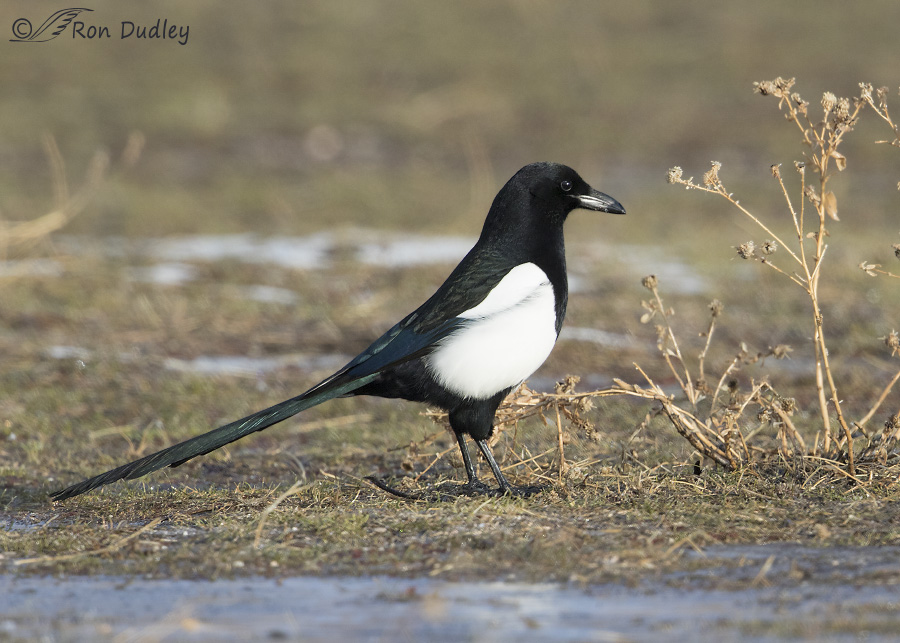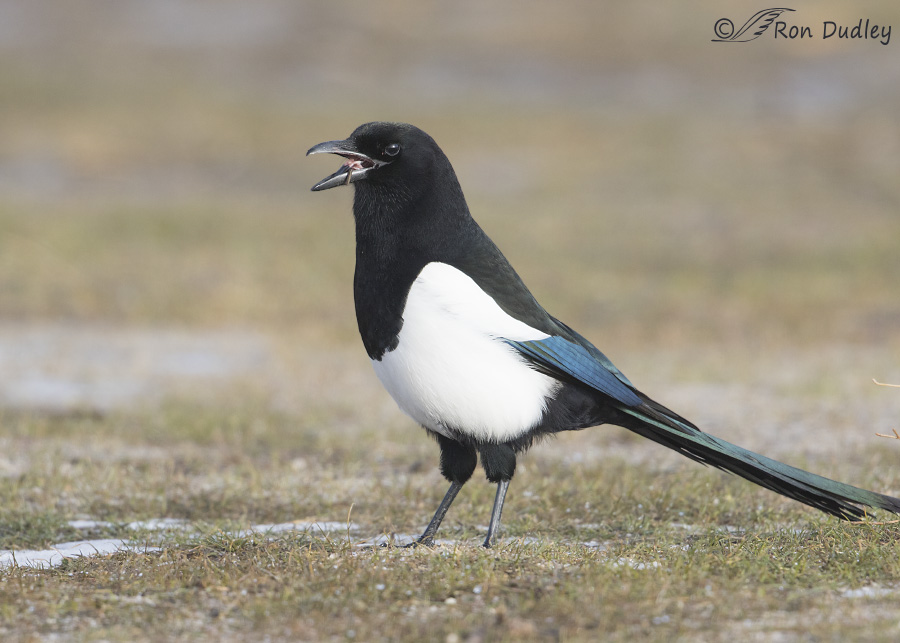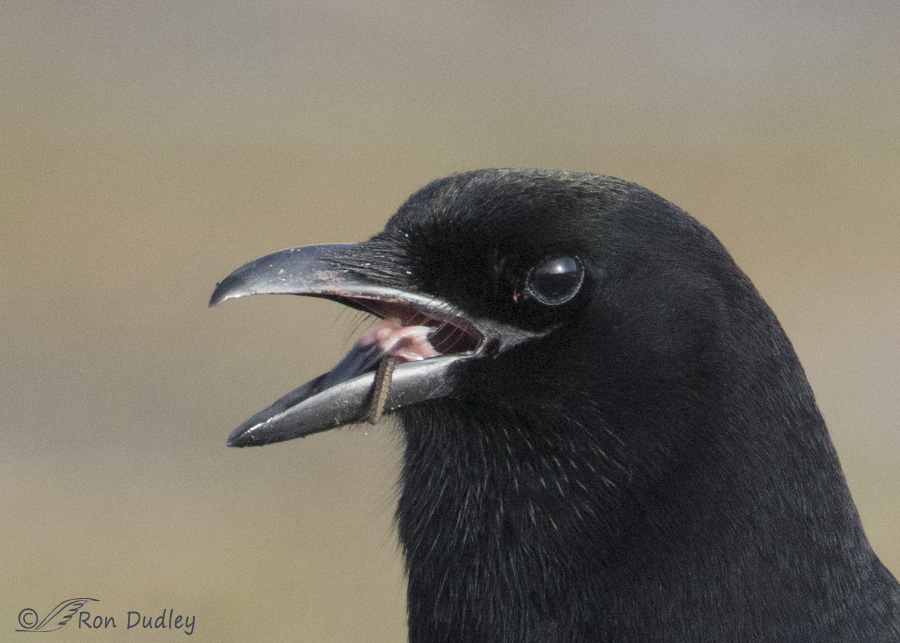My telephoto lens often allows me to see things that surprise me.

1/2500, f/6.3, ISO 800, Canon 7D Mark II, Canon EF 500mm f/4L IS II USM + 1.4 tc, not baited, set up or called in
Two days ago I photographed this Black-billed Magpie and about a half-dozen of his buddies on Antelope Island as they foraged a campsite for food. Magpies are opportunistic feeders and I figured they were looking mostly for food scraps from campers because it was my assumption that there wasn’t much else available on the island for them to eat this time of year except for seeds and occasional road kill and there’s usually not much of that.
I only include this image to set the stage. We’ve had a cold winter so far with lots of snow and low temperatures. This campsite is on a south-facing slope so much of the snow there was gone but the ground stays mostly frozen even when it warms up a little in the afternoons. Morning temperatures on the island have typically been between 10 and 20 degrees F. and sometimes colder (though it’s warmed up a little in recent days). In this image we see patches of snow in the background and ice in the foreground. As I was watching these magpies hopping around looking for food I saw them slip on the ice about a half-dozen times – it was really quite comical but I never got any photos of it.

1/1250, f/6.3, ISO 800, Canon 7D Mark II, Canon EF 500mm f/4L IS II USM + 1.4 tc, not baited, set up or called in
Occasionally I saw one of them pick something up and swallow it but the item was always too small to identify through my lens. But when I got home and saw this image on my screen my curiosity was piqued because I thought it looked like an insect but figured that was highly unlikely this time of year.
I decided to crop tightly on the bird’s head to see if I could tell for sure what it was.

These magpies were apparently eating insects. In northern Utah in the middle of January!
I’m no entomologist but to my eye this prey item looks millipede-ish. I was blown away to find birds eating insects on the island this time of year. Nature is full of surprises but I never even considered this possibility. Perhaps it’s simply a testament to the adaptability of insects and the foraging skills of birds.
Or maybe, just maybe, it’s also a consequence of climate change. After all, just a few days ago NOAHH and NASA jointly announced that 2015 was the warmest year on record (since 1880 when record keeping began) and that December was both the warmest and wettest on record (more on that announcement can be seen here).
I suppose it’s also possible that this isn’t as unusual as I think it is but I wouldn’t expect to see active insects on the island until about March and even then they’d be few and far between.
Ron


Actually I think you mean arthropod rather than insect. Insects have six legs, spiders, 8 and then there are centipedes and millipedes. All of them, are arthropods. But it does amaze me that insects can be present in cold temperatures. We sometimes see a sky full of tree swallows – some of them are spending the winter with us. They were flying today in the low 40’s and we have had a few days when the temps were in the 20 and 30’s. They must be eating flying insects which I find very amazing.
Don’t tell me you actually believe in climate change!!! And you’re a scientist??? Just because 2015 was the warmest year in recorded history…and 2014, 2013, etc. set records for heat!! ( And in places like Florida the water surrounding it is a foot higher). What we need is to rip more fossil feuls out of the earth and burn them (Burn, Baby, burn !!!)—so we can make it warmer, release more carbon dixide, more carbon monoxide, and more particulates into the air. We need more fracking, strip mining, mountains turned inside out and upside down. We need more cars, trucks and bigger factories and less regulation. Who needs trees? Who ( except the gods of profootball) need oxygen??? You can’t even see the stuff. You can’t even mine it and make a profit on it!
If it wasn’t for climate change, if you believe in that nonsense which is probably another Obama plot,( just ask Sarah Palin), that poor Magpie, elegant as he is in his tuxedo, probably wouldn’t have found that juicy prey! I say, “If you care about wildlife ( and I don’t just mean night clubs,concerts, and protests), do your part….pollute more air (earth and water, too)!!!)…..
Wow, Patty – you’re on a roll, this morning. It’s all pretty overwhelming, isn’t it? And depressing…
This will be my platform if I decide to. throw my hat into the ptesidential race…..in the meantime, I’m drinking a lot of tea……
Patty, you need to run!
Ron, our Muscovy Ducks were pecking the ground for bugs yesterday. Granted we are not having freezing temps right now, but we are around 37 in the morning. Today while hiking I spotted a few gnats. That surprised me! We are in the 50’s in the afternoon.
Patty, you really should pass out towels to wipe the sarcasm off your sentences (perhaps a beach-sized towel in this instance?)! LOL! Except it’s really not funny, is it? It’s SO depressing.
Personally, I’ve wondered since sometime in my teenage years where the tipping point is with the number of trees felled (and no longer producing oxygen) to the number of humans on the planet (who need to breathe oxygen). I know there is a tipping point. Just don’t know exactly where it is. And I’m not at all worried about humans falling over dead–I believe in a huge culling of our species (yes, I am a heretic). The problem is other critters on this spinning rock need some oxygen, too.
The other part I cannot and will never understand is that the people making boatloads of money from polluting our air, water and land have children and grandchildren. How do they justify poisoning the planet for their offspring? I don’t understand how they rationalize what they’re doing. There’s got to be some powerful magical thinking that goes along with that.
Do you ever look back to what the Earth looked like when you were a child and then compare that vision to today? Or imagine what it looked like when your grandparents were coming up? Or their grandparents? Scary stuff.
In the meantime, every time I fly my birds and they catch stuff, I’m fearful that those inconvenient critters have been poisoned and will, in turn, poison them. That shouldn’t cross my mind, but I stay as far away from humans as possible to minimize that threat (along with a host of others). Maybe I’m missing prey opportunities, but I’ve got a healthy 16-year-old Harris’ hawk and a 22-year-old redtail hawk.
I’m pontificating…gotta stop that, but I won’t.
As for your photography, Ron, yet again WOW! Corvids, the whole darn family, are my favorite non-raptor, non-Chickadee bird. I need to get back west so that I get to see them regularly. They bring joy to me!
I agree!
That is a fascinating discovery! I do my share of kestrel watching and its always a challenge to try and identify some of the tiny creatures they capture. Kestrels eat a lot of beetles in the winter in my locale. The prey in the magpie’s mouth appears to have either a dorsal or ventral keel that’s apparent in the photo. That suggests the abdomen of an insect of some type in my opinion, or possibly the body of an insect larva. Also the amateur entomologist within me must remind folks that millipedes are not insects. Insects only have six legs.
Mark, I agree, the prey is likely an insect. I think it resembles a millipede (thus “millipede-ish”) but when I blew up the photo even more than I did in this last image I could see no evidence of their namesake “thousand feet”. And of course you’re right – millipedes are not insects, though both are Arthropods. The way I worded it probably suggested they were insects. Thank you.
Very interesting Ron. I am amazed that insects would be out in the cold temps. Whenever I see magpies I think of you and your incredible images you have captured of them! We have a lot of them now, and I need to simply go out in the back orchard and start taking photos. The other morning I saw at least 30 of them in a group. They are eating “something” on the ground, perhaps seeds. Now that I see your photos of them with insects I am more curious. Are you seeing them group together in the winter, more than you see in the other seasons?
“Are you seeing them group together in the winter, more than you see in the other seasons”
Yes, Ed. They seem noticeably more gregarious during winter.
I love photographing them – for their interesting behaviors and curiosity and for the exposure challenge they present.
Know they’ll eat most anything, but haven’t seen that!
You’ve got that right, Judy. They even kill and eat voles occasionally.
I used to feed them carp carcasses after I took filets off of them. And I moved into a mouse-infested house and they ate all the mice I trapped, then got mad when I ran out.
As you know some insects migrate, but not all and some just can’t. Around here there are insects that will hibernate under bark and I’ve seen woodpeckers moving pieces of bark to get to the insect under it. Birds are opportunistic, especially ones that have to find survival in freezing weather.
Interesting stuff – thanks for sharing.
Dick, obviously there’s an explanation for this but I just don’t know what it is. This magpie found the insect on top of the frozen ground. I saw it pick it up.
Yep, the will to survive is the will to be successful. Magpies are that in spades!